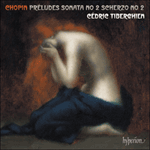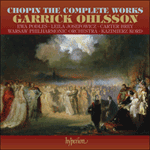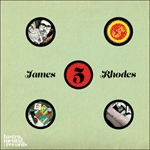
Welcome to Hyperion Records, an independent British classical label devoted to presenting high-quality recordings of music of all styles and from all periods from the twelfth century to the twenty-first.
Hyperion offers both CDs, and downloads in a number of formats. The site is also available in several languages.
Please use the dropdown buttons to set your preferred options, or use the checkbox to accept the defaults.

The B flat minor scherzo, the most popular of the four, opens with a striking phrase which has been aptly cited as an instance of scorn in music: a timid question followed by a forceful put-down. Wilhelm von Lenz, who studied the work with Chopin, reported that for the composer, ‘it was never questioning enough, never piano enough, never vaulted (tombé) enough, never important enough’. And on another occasion: ‘It must be a charnel house.’ There follows one of Chopin’s most inspired lyrical themes (in D flat major, as is the majority of the scherzo) before a chorale-like central section. Here the music becomes increasingly agitated before reaching an impassioned climax and a return to the opening subject. The coda is superbly written and conceived, for now the questioning phrase returns in an altered form followed by the answer. But this time the question has been answered—not with scorn but with complete accord, and the two hurtle together towards the scherzo’s triumphant conclusion.
from notes by Jeremy Nicholas © 2017
Le scherzo en si bémol mineur, le plus populaire des quatre, débute par une phrase saisissante qui a été citée à juste titre comme un exemple de dédain en musique: une question timide suivie d’une vigoureuse remarque humiliante. Wilhelm von Lenz, qui étudia cette œuvre avec Chopin, signala que pour le compositeur, «elle n’était jamais assez interrogatrice, jamais assez piano, jamais assez tombée, jamais assez importante». Et à une autre occasion: «Ce doit être un charnier.» Vient ensuite l’un des thèmes lyriques les plus inspirés de Chopin (en ré bémol majeur, comme la majorité du scherzo) avant une section centrale dans le style d’un choral. Ici, la musique devient de plus en plus agitée avant d’atteindre un sommet passionné et un retour au sujet initial. La coda est une merveille d’écriture et de conception, car la phrase interrogatrice revient à présent sous une forme modifiée suivie de la réponse. Mais maintenant la question a reçu une réponse—pas avec mépris mais avec accord total, et les deux s’élancent ensemble vers la conclusion triomphale du scherzo.
extrait des notes rédigées par Jeremy Nicholas © 2017
Français: Marie-Stella Pâris
Der markante Anfang des Scherzo b-Moll, des beliebtesten der vier Scherzi, wurde treffend als musikalisch gefasste, harsche Zurückweisung beschrieben: eine schüchterne Frage, gefolgt von einer niederschmetternden Antwort. Wilhelm von Lenz, der das Werk mit dem Komponisten einstudierte, berichtete, für diesen sei es „nie genug Frage, nie piano genug, nie genug gewölbt (tombé), nie bedeutsam genug“ gewesen … „Ein Todtenhaus muss es sein!“ Es folgt eines der schönsten lyrischen Themen Chopins (in Des-Dur wie der Großteil des Scherzos), dann ein choralartiger Mittelteil. Hier wird die Musik immer erregter, bevor sie einen passionierten Höhepunkt erreicht und zum Anfangsthema zurückkehrt. Grandios geschrieben und geformt ist die Coda: Hier kehrt die fragende Figur verändert wieder, gefolgt von der Antwort—doch nun ist die Frage beantwortet, und zwar nicht abweisend, sondern zustimmend; und beide Motive stürmen vereint in den triumphalen Schluss des Scherzos.
aus dem Begleittext von Jeremy Nicholas © 2017
Deutsch: Friedrich Sprondel
 Chopin: Préludes, Piano Sonata No 2 & Scherzo No 2 Chopin: Préludes, Piano Sonata No 2 & Scherzo No 2A selection of Chopin’s greatest and most popular works in luminous performances from Cédric Tiberghien.» More |
 Chopin: The Complete Works Chopin: The Complete WorksSince his triumph as winner of the 1970 Chopin International Piano Competition, Garrick Ohlsson has established himself worldwide as a musician of magisterial interpretive and technical prowess. This monumental recording project—first instigated by t ...» More |
 Chopin: The Four Scherzi Chopin: The Four Scherzi‘These works require the utmost in panache and glitter, Demidenko's scintillating fingers provide that in spades’ (Gramophone) ‘Demidenko is one of the most outstanding modern Chopin players … as usual, Demidenko's superb technique is plainly at the service of the music, ...» More |
 Inside tracks - the James Rhodes mix tape Inside tracks - the James Rhodes mix tapeA selection of James Rhodes' personal favourites, tracks taken from his four earlier Signum albums.» More |
 James Rhodes 5 James Rhodes 5Five years on from his debut recording, James Rhodes has firmly established himself in the classical world as a pioneering figure—reaching out through concerts, recordings and television documentaries to create new classical music fans whilst rema ...» More |

